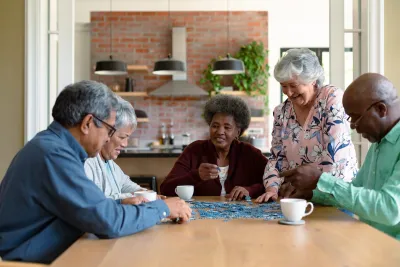Designing for the unique needs of elderly people can help them maintain social connections and mental acuity.

Aging — that of ourselves or of our loved ones — can be a painful subject. Too often, elderly people and their families fear the prospect of moving their older relatives to a senior living facility, worried that it will sever their social connections and accelerate their mental degradation.
But as Michelle Gagnon-Creeley writes in an article for Happy Cities, it doesn’t have to be this way. Designing buildings and communities with older people in mind can support their independence while offering a sense of safety and community.
“Socially connected neighbours are healthier, more resilient, and often able to stay longer in their home and community as they age. The design of our homes can help foster these connections,” Gagnon-Creeley adds. The article summarizes findings from a Happy Cities study that analyzed 20 senior housing buildings in British Columbia, evaluating how they each foster connection and community.
The article outlines four key strategies for designing age-friendly homes: “social homes” that offer opportunities for interaction and accommodate changing mobility needs; “social circulation” that transforms transitional spaces like stairwells and hallways into comfortable, social spaces; “social amenities” that offer activities for stimulation and gathering; and “social building edges,” the transition zones between public and private spaces that can be elevated to provide a visual connection to the street and outdoor recreation areas.
FULL STORY: What makes an age-friendly home?

Study: Maui’s Plan to Convert Vacation Rentals to Long-Term Housing Could Cause Nearly $1 Billion Economic Loss
The plan would reduce visitor accommodation by 25,% resulting in 1,900 jobs lost.

Alabama: Trump Terminates Settlements for Black Communities Harmed By Raw Sewage
Trump deemed the landmark civil rights agreement “illegal DEI and environmental justice policy.”

Why Should We Subsidize Public Transportation?
Many public transit agencies face financial stress due to rising costs, declining fare revenue, and declining subsidies. Transit advocates must provide a strong business case for increasing public transit funding.

Paris Bike Boom Leads to Steep Drop in Air Pollution
The French city’s air quality has improved dramatically in the past 20 years, coinciding with a growth in cycling.

Why Housing Costs More to Build in California Than in Texas
Hard costs like labor and materials combined with ‘soft’ costs such as permitting make building in the San Francisco Bay Area almost three times as costly as in Texas cities.

San Diego County Sees a Rise in Urban Coyotes
San Diego County experiences a rise in urban coyotes, as sightings become prevalent throughout its urban neighbourhoods and surrounding areas.
Urban Design for Planners 1: Software Tools
This six-course series explores essential urban design concepts using open source software and equips planners with the tools they need to participate fully in the urban design process.
Planning for Universal Design
Learn the tools for implementing Universal Design in planning regulations.
Smith Gee Studio
Alamo Area Metropolitan Planning Organization
City of Santa Clarita
Institute for Housing and Urban Development Studies (IHS)
City of Grandview
Harvard GSD Executive Education
Toledo-Lucas County Plan Commissions
Salt Lake City
NYU Wagner Graduate School of Public Service





























